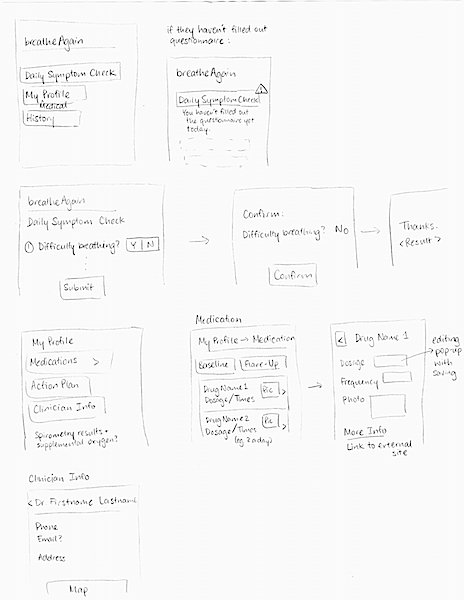COPD Management App
Problem
Chronic obstructive pulmonary disease (COPD) is a group of respiratory diseases that cause airflow blockage and breathing-related problems. Allowing COPD patients to self-manage their disease can reduce hospital admissions and emergency department visits.
I helped develop a mobile application called breatheAgain to help Chronic Obstructive Pulmonary Disorder (COPD) patients manage their disease. In a team of 4, we conducted an operating experience review, functional analysis, and hierarchical task analysis before developing low- and high-fidelity prototypes.
The project was in collaboration with the Centre for Global eHealth Innovation at the Toronto General Hospital.
Impact
I played an active role by conducting a literature review, formulating requirements and design guidelines, developing a section of the prototype, writing the usability study protocol and analyzing study data, and leading project documentation and report-writing.
We delivered our prototypes to our collaborators at the Toronto General Hospital. We provided explanations of all our analyses, a set of design guidelines and requirements, and a design overview of our final prototype.
Process
Operating Experience Review
The Operating Experience Review (OER) consisted of interviews with patients and clinicians, a literature search, and market research on COPD action plans and self-management tools.

The OER helped identify stakeholder needs (patients, clinicians, and developers) for our app.
Functional, Task, and Risk Analyses
We did analyses on what functions would be required from our app, a sample task workflow for users of a COPD management app, and possible risks associated with using the app.
Paper Prototypes
I sketched paper prototypes for the app, which were later iterated upon. As a group, we conducted an internal review of all of our ideas and agreed upon an app workflow.

High-Fidelity Prototype
We developed a high-fidelity prototype of breatheAgain using Axure. I was responsible for the Medication and Resources sections.

Validation
We walked through the prototype with 2 subject matter experts to verify the app content and workflow. We also conducted usability testing on our high-fidelity prototype with 5 participants over the age of 40, including one COPD patient. I wrote the usability study protocol and analyzed the data. Participants performed 8 tasks with the app. We measured time to completion, number of times assistance was required, whether the task was successfully completed, number of errors, and the System Usability Scale (SUS) score. Our app achieved an SUS score of 73.5, which is above the 68 average threshold for the scale.